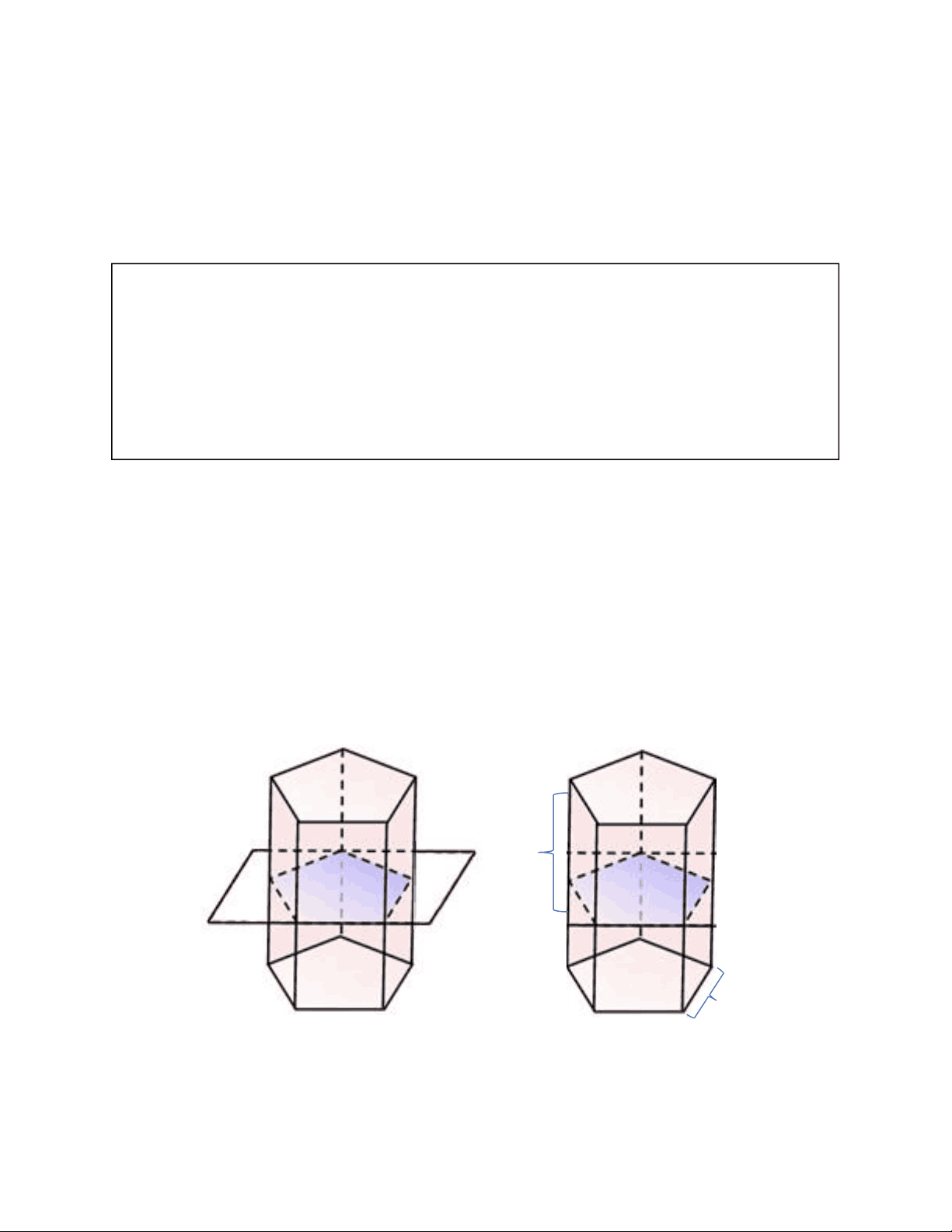
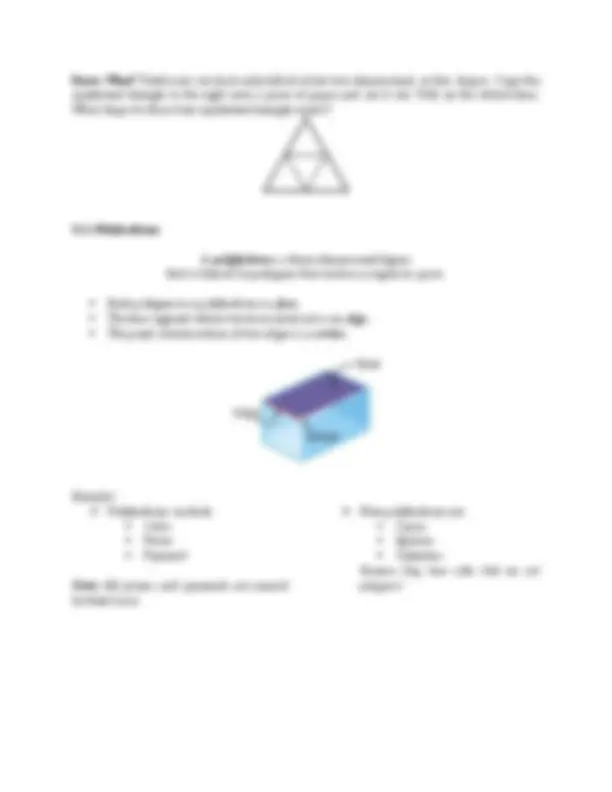
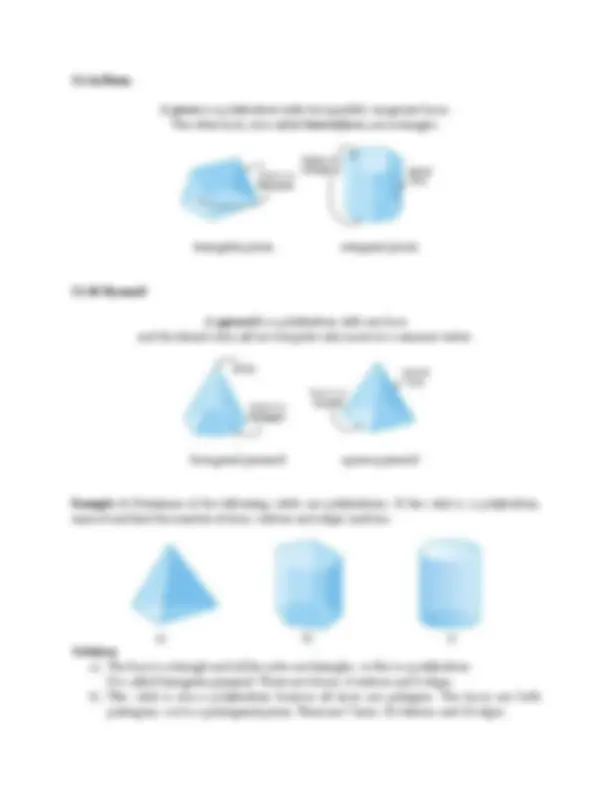
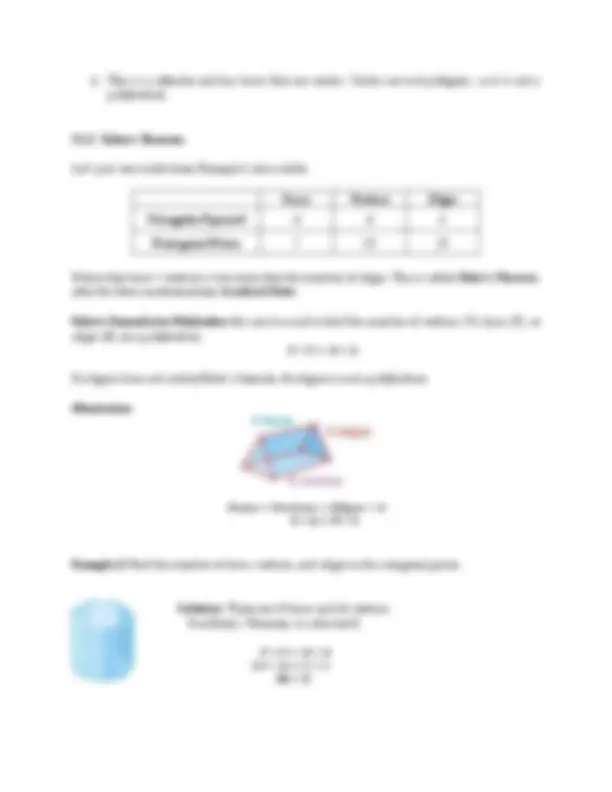
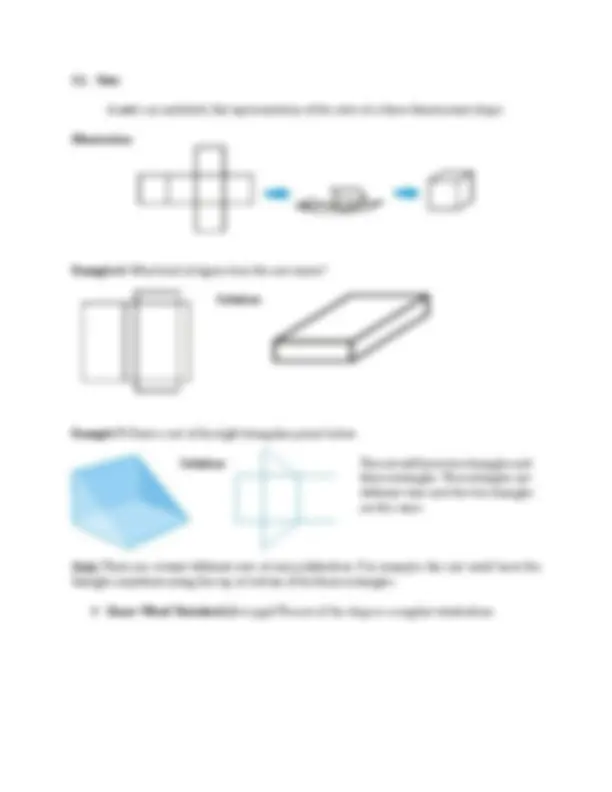


Study with the several resources on Docsity

Earn points by helping other students or get them with a premium plan


Prepare for your exams
Study with the several resources on Docsity

Earn points to download
Earn points by helping other students or get them with a premium plan
Community
Ask the community for help and clear up your study doubts
Discover the best universities in your country according to Docsity users
Free resources
Download our free guides on studying techniques, anxiety management strategies, and thesis advice from Docsity tutors
learn more through this lesson.
Typology: Slides
1 / 8

This page cannot be seen from the preview
Don't miss anything!





3.1 Basic Concepts of Solids 3.2 Measurements of Solids The world around us is obviously three-dimensional (Euclidean space) having height, width, and depth. Understanding solids is a building block for finding their lateral area, surface area, and measurements of volumes of various solid figures. These include pyramids, cylinders, cubes, cones, spheres and prisms. In this chapter, we will discuss some solids with their corresponding formulas for finding volumes, surface areas and its application to practical problems used in real life. The solids that are included in our study are cubes, rectangular parallelepiped, prism, cylinder, pyramid, cone and sphere. Below are the descriptions of the terms used in our study of solids. M At the end of the chapter, students are expected to Identify different geometric solids. Explore the properties and attributes of two and three dimensional figures. Apply the concepts of geometric solids to various real-life problems in the world around them. Vertex Section Face Edge Base
3.1 Basic concept of Solids A solid is any limited portion of a space, bounded by surfaces. Not hallow inside. Figures can be classified according to their dimensions. Two-dimensional figures are plane figures, or “flat” figures. A plane figure is a flat figure that does not have depth to it. Here are some examples of plane figures. Here you have a circle, a triangle and a rectangle. You can see that these figures have been created on one plane. They are two-dimensional figures. Then, there are three-dimensional figures or solid figures. Solid figures are not limited to one plane and have depth. There are many different types of solid figures. Illustration:
Vertex Section Face Edge Base
3.1.1a Prism A prism is a polyhedron with two parallel, congruent bases. The other faces, also called lateral faces , are rectangles. triangular prism octagonal prism 3.1.1b Pyramid A pyramid is a polyhedron with one base and the lateral sides ( all are triangular sides ) meet at a common vertex. hexagonal pyramid square pyramid. Example 1: Determine if the following solids are polyhedrons. If the solid is a polyhedron, name it and find the number of faces, vertices and edges each has. a) b) c) Solution: a) The base is a triangle and all the sides are triangles, so this is a polyhedron. It is called triangular pyramid. There are 4 faces, 4 vertices and 6 edges. b) This solid is also a polyhedron because all faces are polygons. The bases are both pentagons, so it is a pentagonal prism. There are 7 faces, 10 vertices, and 15 edges.
c) This is a cylinder and has bases that are circles. Circles are not polygons, so it is not a polyhedron. 3.1.2 Euler’s Theorem Let’s put our results from Example 1 into a table. Faces Vertices Edges Triangular Pyramid 4 4 6 Pentagonal Prism 7 10 15 Notice that faces + vertices is two more that the number of edges. This is called Euler’s Theorem , after the Swiss mathematician Leonhard Euler. Euler’s Formula for Polyhedra: this can be used to find the number of vertices (V), faces (F), or edges (E) on a polyhedron: 𝐀 + 𝐀 = 𝐀 + 𝐀 If a figure does not satisfy Euler’s formula, the figure is not a polyhedron. Illustration: 𝐀𫐀𝐀𰠀𝐀 + 𝐀𰠀𝐀𱠀𝐀𝐀𰠀𝐀 = 𝐀𫀀𝐀𰠀𝐀 + 𝐀 𝐀 + 𝐀 = 𝐀 + 𝐀 Example 2: Find the number of faces, vertices, and edges in the octagonal prism. Solution: There are 10 faces and 16 vertices. Use Euler’s Theorem, to solve for E. 𝐀 + 𝐀 = 𝐀 + 𝐀 10 + 16 = 𝐀 + 2 𝐀 = 𝐀
Regular Dodecahedron: A 12-faced polyhedron and all the faces are regular pentagons. Regular Icosahedron: A 20-faced polyhedron and all the faces are equilateral triangles. 3.1.4 Cross-Sections One way to “view” a three-dimensional figure in a two-dimensional plane is to use cross- sections. A cross-section is the intersection of a plane with a solid. Illustration: The cross-section of the peach plane and the tetrahedron is a triangle. Example 5: What is the shape formed by the intersection of the plane and the regular octahedron? a) b) c) Solution: a) Square b) Rhombus c) Hexagon
3.1. Nets A net is an unfolded, flat representation of the sides of a three-dimensional shape. Illustration: Example 6: What kind of figure does this net create? Solution: Example 7: Draw a net of the right triangular prism below. Solution: The net will have two triangles and three rectangles. The rectangles are different sizes and the two triangles are the same. Note: There are several different nets of any polyhedron. For example, this net could have the triangles anywhere along the top or bottom of the three rectangles. Know What? Revisited ( first page ) The net of the shape is a regular tetrahedron.